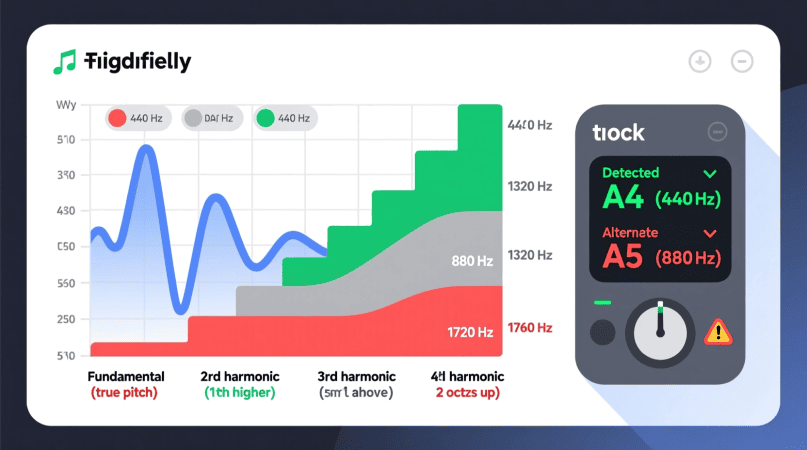
If you’ve ever plucked a guitar string or sung into a tuner and seen the display flicker between different notes, it can feel confusing. The truth is your tuner isn’t broken—it’s reading harmonics, not just the main pitch.
Let’s unpack why this happens, how harmonics work, and what you can do to get accurate tuning.
What Are Harmonics?
When you play or sing a note, you don’t produce a single, pure frequency. Instead, the sound contains:
- Fundamental frequency: the lowest vibration, the pitch you perceive (e.g., A2 = 110 Hz).
- Harmonics (overtones): higher frequencies that are integer multiples of the fundamental (220 Hz, 330 Hz, 440 Hz, etc.).
These harmonics shape the timbre of your instrument or voice and make a piano sound different from a violin, even when playing the same note.
Why Tuners Show Multiple Notes
Tuners detect strong frequency peaks in your sound. If the fundamental is weak or buried under overtones, the tuner may lock onto a harmonic instead.
Common tuner misreads:
- Detecting the 2nd harmonic → shows the octave above.
- Detecting the 3rd harmonic → shows a fifth above the octave.
- Detecting mixed partials → tuner flickers between two notes.
That’s why your tuner sometimes insists you’re playing a different note than you actually are.
How to Get More Accurate Tuning
Here are some practical tips to help your tuner read the fundamental pitch more consistently:
- Play or sing cleanly – reduce noise and avoid excessive vibrato.
- Pluck near the center of the string – this emphasizes the fundamental rather than higher harmonics.
- Use the right tuner mode – some tuners are optimized for guitar, bass, or vocals.
- Try a real-time tuner – tools like our real-time pitch detector show both the note and its harmonics visually, so you can see exactly what’s happening.
Harmonics at a Glance
| Harmonic | Frequency Ratio | Interval Heard | Tuner Might Show |
|---|---|---|---|
| 1st | 1:1 | Fundamental (root) | Correct note |
| 2nd | 2:1 | Octave | Higher octave |
| 3rd | 3:1 | Perfect fifth above | Wrong note flicker |
| 4th | 4:1 | Two octaves above | Higher octave |
FAQs
Q: Why does my tuner jump between two notes?
Because it’s detecting both the fundamental and a strong harmonic.
Q: Which harmonics confuse tuners the most?
Typically the 2nd (octave) and 3rd (fifth).
Q: How can I make sure my tuner shows the right note?
Pluck or sing steadily, emphasize the fundamental, and use a tuner designed for your instrument.
Q: Are some tuners better with harmonics?
Yes, strobe and spectrum tuners handle overtones more accurately than basic needle tuners.
Pitch Detector is a project by Ornella, blending audio engineering and web technology to deliver precise, real-time pitch detection through your browser. Designed for musicians, producers, and learners who want fast, accurate tuning without installing any software.
